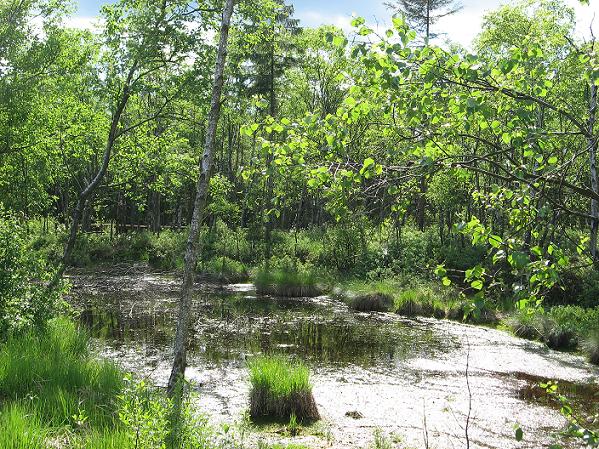11 Jun 2012
Raised Bog in the Solling-Vogler Nature Park
The weather didn't play nice last week, raining on the Queen's jubilee and generally making a nuisance of itself. Though around here the trees and plants needed the water; it had been very dry. Still, it's a good reason to post some sunny photos.

Timber trackway in the Mecklenbruch bog
The Solling-Vogler Nature Park lies to the north-west of Göttingen, stretching down to the Weser river. The other Nature/National Park I've been posting about several times, the Harz, is to the north-east. The mountains in the Solling are gentler than the highest Harz ones, but both landscapes belong to the German mittelgebirge (another word the English language snagged out of our pocket, it seems).

A tower for a better overview
The name Mecklenbruch likely developed from a Old Saxon Mekelenbroik, meaning 'large swamp.' The area was first mentioned in a charte from 1575. Since 1800, the peat was used to fire the glass making furnaces; later, drainage canals were added and the bog almost destroyed.

View from the tower over the bog
The Mecklenbruch bog encompasses 63 hectares; only a small part of it is accessible via the timber trackway, the rest is left free of any human influence. A project to undo the human-made changes is going on since the 1980ies, and the bog stands a good chance to survive, though it will take several decennies for it to regain its former nature.

View from the tower, different angle
A raised bog needs a cool and wet (minimum of 800 mm rain per annum) climate to develop, because raised bogs don't have any contact to groundwater. The second requirement is an acidic substrate that's impermeable to water - in case of the Mecklenbruch that is provided by a layer of weathered sandstone and loess that developed during the last Ice Age. Raised bogs are also called ombrotrophic (rain-fed).

View to the trackway
And that's how it works. What started out as lake would over time turn into a marsh, then fen, carr (a peat or silt filled lake; see photo below) and eventually a bog. Sphagnum mosses will settle on the saturated ground; they can take up 20-30 times their own dry weight in water. While their lower part slowly decays and turns into peat, the moss layer grows in height, eventually raising the ground beyond groundwater level. At that point, we call it a raised bog. It took 4500 years for a 5 metres high peat layer to develop under those conditions.

A carr in the Mecklenbruch bog
Thus the centre of an ombotrohpic bog is a treeless dome with true bog conditions, while strips of fen, carrs, and wetland vegetation (moor birches, Norway spruces and shrubs) are found in the outskirts. Those areas may be reached by groundwater. The trackway in the Mecklenburch bog leads through that sort of terrain for the most; the true bog can best be seen from the tower.

A little lake
There are similar raised bogs in the Harz, and most of those are not accessible to the public, either. The Harz had another problem that endangered the bogs: the waterworks needed for mountaineering (esp. silver). There is a whole system of artificial lakes that would provide water power to wash ore out of the stone. That system today is a Cultural Heritage; the Oderteich is part of it.
Some drama queen clouds
The clouds on the last photo looked very dramatic, but they didn't pose any real threat; the day remained fine and dry.
Below are some more photos.
The raised bog in August
You can see that on the fringes, the bog turns into a swamp with more shrubs and trees that tolerate watery surroundings, and no more sphagnum mosses.
The heather in bloom
While the first potos were taken in spring, I took another tour in August when the heather was in bloom.
A bog pond
The next time I returned to the Meckelnbruch was an autumn afternoon. The atmosphere was pretty different though it was a sunny day as well.

A view from the tower
Somehow, autumn fits bogs and moors even better than late spring. The colours were just lovely, all those shades of yellow and brown, and a deep blue sky mirroring in the dark lakes.

Another view, to the other side
The bog is the home of a number of endangered flora (fe. sundew, a sort of cranberry - Vaccinium oxycoccus) and fauna (dragonflies), though I didn't manage to catch any of those pretties on the camera (and the sundew is in the inaccessible part of the bog).

The timber trackway

One of several little lakes
I took those photos in late October.

The carr in a hazy autumn sun

A stand of young birches
Mecklenbruch Bog / Solling in autumn
The weather didn't play nice last week, raining on the Queen's jubilee and generally making a nuisance of itself. Though around here the trees and plants needed the water; it had been very dry. Still, it's a good reason to post some sunny photos.

The Solling-Vogler Nature Park lies to the north-west of Göttingen, stretching down to the Weser river. The other Nature/National Park I've been posting about several times, the Harz, is to the north-east. The mountains in the Solling are gentler than the highest Harz ones, but both landscapes belong to the German mittelgebirge (another word the English language snagged out of our pocket, it seems).

The name Mecklenbruch likely developed from a Old Saxon Mekelenbroik, meaning 'large swamp.' The area was first mentioned in a charte from 1575. Since 1800, the peat was used to fire the glass making furnaces; later, drainage canals were added and the bog almost destroyed.

The Mecklenbruch bog encompasses 63 hectares; only a small part of it is accessible via the timber trackway, the rest is left free of any human influence. A project to undo the human-made changes is going on since the 1980ies, and the bog stands a good chance to survive, though it will take several decennies for it to regain its former nature.

A raised bog needs a cool and wet (minimum of 800 mm rain per annum) climate to develop, because raised bogs don't have any contact to groundwater. The second requirement is an acidic substrate that's impermeable to water - in case of the Mecklenbruch that is provided by a layer of weathered sandstone and loess that developed during the last Ice Age. Raised bogs are also called ombrotrophic (rain-fed).

And that's how it works. What started out as lake would over time turn into a marsh, then fen, carr (a peat or silt filled lake; see photo below) and eventually a bog. Sphagnum mosses will settle on the saturated ground; they can take up 20-30 times their own dry weight in water. While their lower part slowly decays and turns into peat, the moss layer grows in height, eventually raising the ground beyond groundwater level. At that point, we call it a raised bog. It took 4500 years for a 5 metres high peat layer to develop under those conditions.

Thus the centre of an ombotrohpic bog is a treeless dome with true bog conditions, while strips of fen, carrs, and wetland vegetation (moor birches, Norway spruces and shrubs) are found in the outskirts. Those areas may be reached by groundwater. The trackway in the Mecklenburch bog leads through that sort of terrain for the most; the true bog can best be seen from the tower.

There are similar raised bogs in the Harz, and most of those are not accessible to the public, either. The Harz had another problem that endangered the bogs: the waterworks needed for mountaineering (esp. silver). There is a whole system of artificial lakes that would provide water power to wash ore out of the stone. That system today is a Cultural Heritage; the Oderteich is part of it.
The clouds on the last photo looked very dramatic, but they didn't pose any real threat; the day remained fine and dry.
Below are some more photos.
You can see that on the fringes, the bog turns into a swamp with more shrubs and trees that tolerate watery surroundings, and no more sphagnum mosses.
While the first potos were taken in spring, I took another tour in August when the heather was in bloom.
The next time I returned to the Meckelnbruch was an autumn afternoon. The atmosphere was pretty different though it was a sunny day as well.

Somehow, autumn fits bogs and moors even better than late spring. The colours were just lovely, all those shades of yellow and brown, and a deep blue sky mirroring in the dark lakes.

The bog is the home of a number of endangered flora (fe. sundew, a sort of cranberry - Vaccinium oxycoccus) and fauna (dragonflies), though I didn't manage to catch any of those pretties on the camera (and the sundew is in the inaccessible part of the bog).


I took those photos in late October.


Comments:
<< Home
I've occasionally seen sundew in wet places in Cumbria, but only once or twice. Fascinating plant, and very pretty. I remember it being much smaller than I thought it would be (which makes me wonder if I've overlooked it in other places!). A raised bog is different from the sort of peat bog I'm familiar with on uplands (I think that might be blanket bog). I think Lindow Moss, where Lindow Man was found, is a raised bog. Has the Mecklenbruch bog been associated with archaeological finds?
It's still raining here! and yes, nice to see some sunny photos. Judging by how green the land is, you must get a fair amount of rain there:>
Carla, I don't know about any significant finds in the Harz or Solling bogs, but those haven't been used for getting peat for a long time. We got blanket bogs in the Northern German Plain, and those have rendered a whole array of finds from bodies, to boats, and swords. :)
Anerje, we got enough now, but St.Peter doesn't seem to have notices. ;)
Post a Comment
Anerje, we got enough now, but St.Peter doesn't seem to have notices. ;)
<< Home






